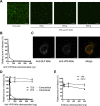Intracellular neutralisation of rotavirus by VP6-specific IgG
- PMID: 32750093
- PMCID: PMC7428215
- DOI: 10.1371/journal.ppat.1008732
Intracellular neutralisation of rotavirus by VP6-specific IgG
Abstract
Rotavirus is a major cause of gastroenteritis in children, with infection typically inducing high levels of protective antibodies. Antibodies targeting the middle capsid protein VP6 are particularly abundant, and as VP6 is only exposed inside cells, neutralisation must be post-entry. However, while a system of poly immune globulin receptor (pIgR) transcytosis has been proposed for anti-VP6 IgAs, the mechanism by which VP6-specific IgG mediates protection remains less clear. We have developed an intracellular neutralisation assay to examine how antibodies neutralise rotavirus inside cells, enabling comparison between IgG and IgA isotypes. Unexpectedly we found that neutralisation by VP6-specific IgG was much more efficient than by VP6-specific IgA. This observation was highly dependent on the activity of the cytosolic antibody receptor TRIM21 and was confirmed using an in vivo model of murine rotavirus infection. Furthermore, mice deficient in only IgG and not other antibody isotypes had a serious deficit in intracellular antibody-mediated protection. The finding that VP6-specific IgG protect mice against rotavirus infection has important implications for rotavirus vaccination. Current assays determine protection in humans predominantly by measuring rotavirus-specific IgA titres. Measurements of VP6-specific IgG may add to existing mechanistic correlates of protection.
Conflict of interest statement
The authors have declared that no competing interests exist.
Figures





References
Publication types
MeSH terms
Substances
Grants and funding
LinkOut - more resources
Full Text Sources
Other Literature Sources
Medical
Miscellaneous

